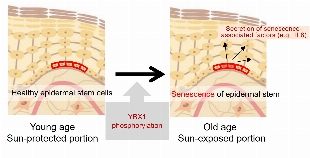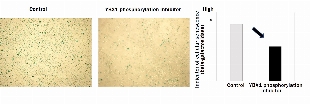June 14, 2023
(press release)
–
~Further advances in skin stem cell research to shed light on ”quality” in addition to ”quantity”~ Shiseido has revealed through 5 years collaborative research with the Cutaneous Biology Research Center (CBRC)*1 at Massachusetts General Hospital that phosphorylation*2 of the RNA*3-binding protein YBX1*4, which suppresses epidermal stem cell senescence, reduces its function, thereby inducing cellular senescence. It has also demonstrated that the inhibition of YBX1 phosphorylation increases the number of epidermal stem cells, suggesting that in order to maintain the quantity of epidermal stem cells, the ”quality” of epidermal stem cells also is important. By applying these results, we aim to approach various skin aging-related issues via suppression of epidermal stem cell senescence. Figure 1. Phosphorylation of YBX1 induces senescence of epidermal stem cells Research background Skin turnover, which occurs as a result of cells in the epidermis constantly proliferating and differentiating, is important to maintain healthy skin. Epidermal stem cells*5 are the sources of these cells and are found in the deepest part of the epidermis called basal layer. Shiseido has been engaged in epidermal stem cell research for 10 years, believing that it is very important to maintain healthy epidermal stem cells in order to realize youthful skin. As a result, we have discovered that supporting the maintenance of epidermal stem cells through the basement membrane, which lies beneath the basal layer of the epidermis, contributes to the retention of skin moisture and barrier function, and even the production of collagen in the dermis. Phosphorylation of YBX1 induces senescence of epidermal stem cells In this study, Associate Professor Mandinova's team at CBRC and Shiseido revealed that phosphorylated YBX1 observed in many of epidermal stem cells collected from donors of different ages showed reduced function. Moreover, when a drug that inhibits the phosphorylation of YBX1 was added to the cultured cells containing epidermal stem cells, and beta-galactosidase (beta-Gal), an indicator of cellular senescence, was stained (Figure 2, left, blue) to compare their quantities (Figure 2, right), the results indicated a suppressing effect of the drug on cellular senescence. YBX1 phosphorylation occurs as a result of photoaging In the real human skin, a decrease in YBX1-positive cells was observed with a reduction in epidermal stem cells due to aging or the influence of sunlight exposure. On the other hand, compared with the portion of the skin that was not exposed to sunlight (sun-protected portion), the part of the skin exposed to sunlight (sun-exposed portion) had a significantly increased level of phosphorylated YBX1 (Figure 3). These results suggest that changes in the skin caused by exposure to sunlight over prolonged periods of time, i.e., photoaging, may be a factor contributing to YBX1 phosphorylation. With the above discovery, it has become clear that the function of YBX1, an essential protein in the suppression of epidermal stem cell senescence, is reduced due to phosphorylation, and this, in turn promotes epidermal stem cell senescence. Shiseido believes that it is essential to maintain a healthy condition of epidermal stem cells, which are also the source of skin turnover to realize youthful skin. We will continue to advance epidermal stem cell research with the aim of developing approaches to addressing various skin concerns caused by aging. *The content of the release is correct as of the time of release, but please note that it may in some cases differ from the latest information.
The results of this study were presented in part at the International Societies of Investigative Dermatology Meeting, ISID 2023, held in Tokyo on May 10–13 by both sides of CBRC and Shiseido.
*1 Cutaneous Biology Research Center (CBRC) is a general research institute for advanced research and development in the field of dermatology established by Harvard Medical School and Massachusetts General Hospital with support from Shiseido in 1989. Shiseido has also been sending research staff to CBRC to conduct joint studies with world-class researchers.
*2 One of post-translational modifications of proteins; when phosphate groups are attached to proteins, changes in their structure and activity occur.
*3 Ribonucleic acid: The genetic information held in deoxyribonucleic acid (DNA) is transcribed into RNA, and this information is used to synthesize proteins.
*4 YBX1 (Y-box binding protein-1). It is known to regulate cellar functions by binding to DNA and RNA and thereby controlling the synthesis of proteins in the transcription and translation processes.
Our collaboration research partner, the team led by Associate Professor Anna Mandinova at CBRC, has revealed in their previous studies that a decrease in the level of the RNA-binding protein YBX1 leads to senescence of epidermal stem cells and also promotes the secretion of proteins that induce senescence of surrounding cells. In the present study, we took on the challenge of further advancing our stem cell research by focusing on the changes in the quality of epidermal stem cells as well as quantity.
*5 Epidermal stem cells: In this study, cells expressing melanoma-associated chondroitin sulfate proteoglycan (MCSP) on the cell surface were treated as epidermal stem cells.
・Figure 2. A drug that has an inhibitory effect on YBX1 phosphorylation suppresses cellular senescence in cultured cells containing epidermal stem cells.
Inhibition of YBX1 phosphorylation increases epidermal stem cells
It was found that when a piece of human skin was cultured with a drug that inhibits YBX1 phosphorylation, the number of epidermal stem cells increased (Figure 4).
・Figure 3. Phosphorylated YBX1 (red) in cells in the epidermal layer (area indicated by the double-headed arrow) increases due to photoaging
・Figure 4. Inhibition of YBX1 phosphorylation increases epidermal stem cells (green and red parts: epidermal stem cellular proteins)

About our R&D strategy:
The results generated in this study, which was conducted under ”Skin Beauty INNOVATION,” one of the three pillars of Shiseido's R&D strategy, represent an achievement of the 10-year-long collaboration between Shiseido and CBRC in the United States, one of the world's leading research institutions.
- Integrated Report 2022 (Beauty Innovation)
https://corp.shiseido.com/report/en/2022/value_creation/innovation/
- Keywords
Skin Beauty INNOVATION, stem cell
Reference: History of collaborative research between CBRC and Shiseido on the epidermal basement membrane and stem cells
The Cutaneous Biology Research Center (CBRC), established by Harvard Medical School Dermatology Research Labs and Massachusetts General Hospital in Boston, Massachusetts, USA, is known as one of the world's best research institutes in the field of dermatology. Shiseido started collaborative research on the epidermal basement membrane with CBRC in 1989, the year the Center was founded. Since then, we have clarified the damage and changes in the structure of the epidermal basement membrane in the early stages of aging. For this achievement, Shiseido was awarded the top prize in the basic research category at the International Federation of Societies of Cosmetic Chemists (IFSCC) Congress 2000 in Berlin*6. As we continued to study the epidermal basement membrane in our laboratory, we also discovered that aging-induced damage to the epidermal basement membrane was related to decreases in epidermal stem cells*7. Moreover, with regard to epidermal stem cells, we initiated collaborative research in 2015. We produced the present research findings—the major achievement in dermatological research obtained through over 30 years of collaborative work between Shiseido and CBRC.
*6 Initial stage care from the inside for the gradual advance of aging! https://corp.shiseido.com/en/rd/ifscc/09.html
*7 Shiseido Researcher Shunsuke Iriyama receives the Otaka award at the annual meeting of the Japanese Society of Matrix Biology and Medicine https://corp.shiseido.com/jp/news/detail.html?n=00000000003230(Japanese only)
【Related News Releases】
Shiseido discovers for the first time in the world that epidermal stem cells affect skin moisture (2015)
https://corp.shiseido.com/jp/newsimg/archive/00000000001832/1832_p2i83_jp.pdf(Japanese only)
Shiseido develops a new active ingredient—a step closer to ”skin rejuvenation” for all customers (2018)
https://corp.shiseido.com/jp/news/detail.html?n=00000000002573(Japanese only)
Shiseido Marks the 30th Anniversary of Joint Research in Dermatology (2019)
https://corp.shiseido.com/en/news/detail.html?n=00000000002755
Shiseido confirms that maintaining epidermal stem cells contributes to dermal collagen fiber regeneration (2021)
https://corp.shiseido.com/jp/news/detail.html?n=00000000003159(Japanese only)
* All content is copyrighted by Industry Intelligence, or the original respective author or source. You may not recirculate, redistrubte or publish the analysis and presentation included in the service without Industry Intelligence's prior written consent. Please review our terms of use.





